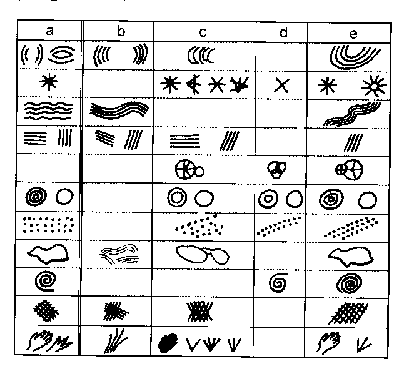Universals in arts
 Figure 1. A comparison of (a) phosphene motifs with (b-e) the motif ranges of specific early graphic palaeoart traditions.
|
So far, two ways of studying relationships between different corpora of rock art have been defined. The first, development through cultural continuity, obviously requires such uninterruptedness, which is the factor providing the necessary link. In the second case, in which there are reactions to alien rock arts recorded (e.g. iconoclasm, commentary, correction, ‘improvement’, adoption), the link is not cultural, but spatial: it is provided simply by the location, through the relative permanence of the rock art at the site of its occurrence.
A third way of linking different bodies of rock art is neither cultural nor spatial. One can compare with it rock art corpora that occur in different continents, are from different periods and lack any cultural connection. This link is provided by the human brain and visual system, and the connection is made via universals in art. This approach is concerned with neural processes, motor actions and hominid endeavours of creating realities through art. Cognitive universals in art are a ferociously complex subject, and here is not the place to examine these complexities in any detail (cf. Bednarik 1990/91). This is not about simplistic applications of universals, as in the claims of shamanism, fertility imagery, hunting magic etc., but one can regard all forms of graphic art (rock art, portable two-dimensional art, tribal arts, body decoration, children’s art, graffiti, subconscious doodling, fine arts etc.) as being tied together by certain forms of graphic universals. The perhaps most outstanding example are the phosphene motifs, derived from an autogeneous and involuntary phenomenon of the mammalian visual system. Their form constants cannot be influenced by cultural conditioning and seem to be ontogenically stable. Phosphene forms are any of the fifteen known standard form constants of phosphenes (Knoll and Kugler 1959; Kellogg et al. 1965; Eichmaier and Höfer 1974). They occur in many graphic art traditions, even to the complete exclusion of any other motif forms (Bednarik 1984, 1994b). For instance, all graphic art of infants prior to the acquisition of iconographic skills is thought to consist of phosphene forms, as apparently does all pre-iconic graphic palaeoart (i.e. prior to about 33 000 BP) (see Figure 1 above). Since this proposition was first presented in 1984, it has never been falsified, but it has strongly been confirmed (Hodgson 2000).
One more interpretational approach via universals is the semiotic study of rock art. Motifs can be regarded as signs or symbols, and their relationships with what they represent can be studied from the perspectives of semantics. However, to what extent such relationships, or the syntactic systems employed in rock art production, can be accessed without relying upon ethnography or archaeological constructs remains to be established. The several forays so far into the semiotic study of palaeoart systems, such as a special issue of the journal Semiotica, edited by Paul Bouissac in 1994, have not yielded sufficient substance to demonstrate a broad validity of this approach. Ultimately its future is likely to be decided by its ability to formulate its propositions in a refutable format.
R. G. Bednarik, 2001